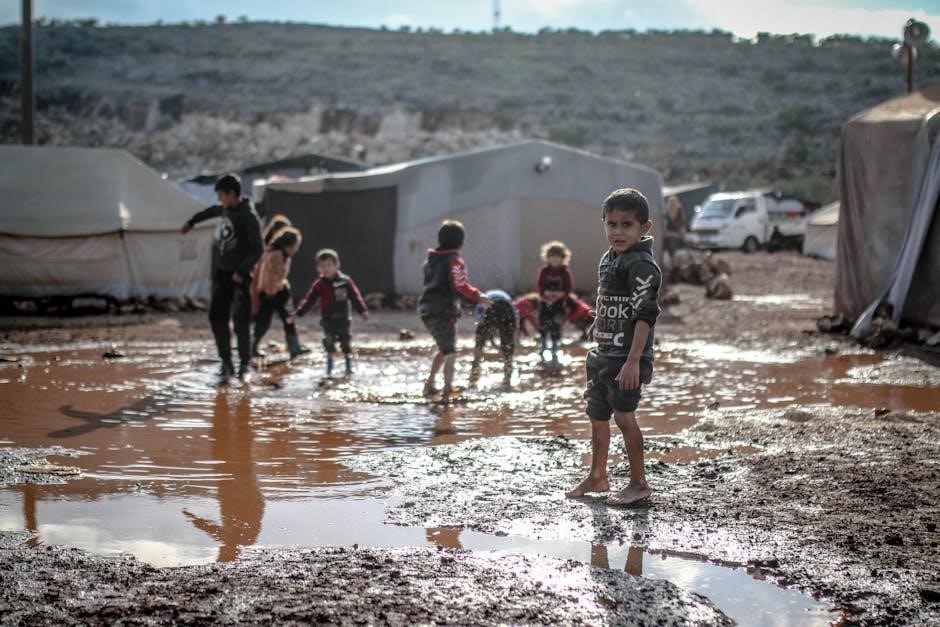Auschwitz, established in 1940, was a Nazi concentration and extermination camp central to the Holocaust. Its harrowing conditions and mass extermination made survival extraordinarily rare, with approximately 1.1 million deaths. The camp’s liberation on January 27, 1945, marked a pivotal moment in history, now commemorated as International Holocaust Remembrance Day. Survivors’ accounts reveal the emotional and psychological trauma endured, emphasizing the camp’s significance in understanding the Holocaust’s atrocities and human resilience.
1.1 Historical Context of Auschwitz
Auschwitz was established in 1940 near Oswiecim, Poland, as a concentration camp for Polish prisoners. It evolved into a vast network of camps, including Auschwitz-Birkenau, which became central to the Holocaust. The SS operated the camp, and by 1942, it was a key site for the implementation of the “Final Solution,” the Nazi plan for the extermination of Jews. Auschwitz symbolized the systematic genocide of six million Jews and millions of others during World War II. The camp’s liberation by Soviet troops on January 27, 1945, revealed its unimaginable horrors, marking it as a defining symbol of the Holocaust and human atrocities.
1.2 The Purpose of Auschwitz
Auschwitz primarily served as a concentration and extermination camp, central to the Nazis’ “Final Solution.” Its main purpose was the systematic genocide of Jews, alongside the persecution of other targeted groups. The camp facilitated mass murder through gas chambers and forced labor under brutal conditions. Auschwitz also functioned as a site for pseudo-scientific experiments, exploiting prisoners for twisted research; The camp’s design and operations were optimized for efficiency in extermination, reflecting the Nazi regime’s intent to eliminate perceived enemies of the state. Auschwitz’s dual role as a labor camp and death factory underscored its significance in the Holocaust’s machinery of terror and destruction.
1.3 The Liberation of Auschwitz
Auschwitz was liberated on January 27, 1945, by the Soviet Red Army, marking a critical end to the camp’s atrocities. Upon arrival, soldiers found approximately 7,000 survivors, many severely ill and malnourished. The camp’s state revealed unimaginable horrors, including gas chambers, crematoria, and vast evidence of mass murder. Liberation brought hope to survivors, though many had endured unimaginable suffering. This day is now commemorated as International Holocaust Remembrance Day, honoring the victims and survivors. The liberation of Auschwitz serves as a poignant reminder of the Holocaust’s atrocities and the resilience of those who survived, ensuring their stories are never forgotten.

The Liberation of Auschwitz
Auschwitz was liberated by the Soviet Red Army on January 27, 1945, freeing 7,000 survivors. This marked a turning point in history, offering hope and closure to those who endured unimaginable suffering.
2.1 The Soviet Advance and Liberation
The Soviet Red Army’s advance into Eastern Europe in early 1945 led to the liberation of Auschwitz on January 27. As Allied forces approached, the Nazis evacuated most prisoners on a brutal death march, leaving behind only the sickest. Upon entering the camp, Soviet soldiers found approximately 7,000 survivors, many in critical condition. The liberation revealed the full extent of the camp’s horrors, including mass graves and gas chambers. This pivotal moment marked the end of Auschwitz’s reign of terror and brought international attention to the Holocaust’s atrocities, ensuring its memory would never fade.
2.2 The State of the Camp at Liberation
When Soviet troops liberated Auschwitz on January 27, 1945, they found approximately 7,000 survivors, many severely ill and malnourished. The camp was in a state of utter devastation, with overcrowded barracks, inadequate sanitation, and widespread disease. Evidence of mass murder, including gas chambers and crematoria, lay intact, while personal belongings of victims—clothing, shoes, and luggage—were scattered, testifying to the scale of the atrocities. The liberation revealed the brutal conditions endured by prisoners and the systematic nature of the Holocaust, leaving an indelible mark on history and serving as a stark reminder of humanity’s darkest chapter.
2.3 Survivor Testimonies from Liberation Day
Survivors of Auschwitz vividly recount the liberation as a mix of relief and disbelief. Many were frail, suffering from starvation and illness, while others expressed gratitude toward Soviet soldiers. Testimonies highlight the emotional complexity of the moment—joy intertwined with grief for lost loved ones. Survivors like Rachel Levy and Leon Weintraub shared harrowing stories of their experiences, emphasizing the atrocities they endured. These accounts provide a poignant glimpse into the human cost of the Holocaust and serve as a testament to resilience. Their voices underscore the importance of remembrance and education to prevent future atrocities, ensuring the world never forgets the horrors of Auschwitz.

Survival in Auschwitz
Survival in Auschwitz was a daily battle against brutal conditions, forced labor, and relentless oppression. Prisoners faced constant threats of death, yet resilience and hope sustained many amidst unimaginable horrors.
3.1 The Initial Selection Process
Upon arrival at Auschwitz, prisoners underwent an initial selection process conducted by Nazi officers. This process determined who would be sent to forced labor and who would be immediately murdered in the gas chambers. Factors such as age, health, and ability to work were considered. The selections were chaotic and dehumanizing, often based on arbitrary criteria. Those deemed unfit for labor, including children, the elderly, and the sick, were sent directly to their deaths. The process was designed to maximize the efficiency of the camp’s extermination and labor systems, leaving survivors with vivid memories of the initial horrors they endured upon arrival.
3.2 Daily Life in the Camp
Daily life in Auschwitz was marked by relentless brutality and inhumane conditions. Prisoners were awoken at 4:30 AM in summer and 5:30 AM in winter by a gong, forcing them to quickly wash and tidy their quarters. Roll calls, often lasting hours, were conducted to count prisoners, during which any mistakes could result in severe punishment. Workdays were filled with exhausting labor, while evenings brought meager rations and overcrowded living conditions. The constant threat of disease, malnutrition, and physical abuse made survival a daily struggle. These harsh conditions were designed to break the spirit and maintain control over the imprisoned population.
3.3 Strategies for Survival

Survival in Auschwitz required a combination of luck, resilience, and strategic actions. Many prisoners formed social networks, sharing resources and providing mutual support to endure the harsh conditions. Others secured better work assignments or positions within the camp hierarchy, which offered slightly improved conditions. Mental strength played a crucial role, as maintaining hope and dignity helped prisoners cope with the constant violence and despair. Some survivors also relied on their skills, such as craftsmanship or knowledge of languages, to gain preferential treatment. Despite these strategies, survival remained precarious, as even small mistakes could lead to severe punishment or death, emphasizing the camp’s brutal environment.
3.4 The Role of Labor in Survival
Labor played a critical role in survival at Auschwitz, as prisoners assigned to work often had better chances of enduring the camp’s harsh conditions. Those with skills, such as craftsmanship or technical expertise, were frequently selected for indoor or less physically demanding tasks, which reduced exposure to extreme weather and brutality. Labor also served as a means of control, keeping prisoners occupied and exhausted, thereby suppressing resistance. While the Nazis exploited labor for their war efforts, some prisoners used their positions to subtly aid others, sharing resources or information. Ultimately, labor was both a tool of oppression and a limited means of survival in the camp’s brutal environment.
3.5 Health and Medical Conditions
Health and medical conditions were dire at Auschwitz, with prisoners facing widespread malnutrition, disease, and inadequate medical care. The camp’s overcrowded and unsanitary living conditions led to the rapid spread of illnesses such as typhus, dysentery, and tuberculosis. Medical facilities were poorly equipped, and SS doctors often used prisoners for brutal experiments rather than providing treatment. Many prisoners died from preventable diseases or were selected for the gas chambers due to their poor health. Despite these challenges, some prisoners managed to survive by accessing limited medical resources or receiving help from fellow inmates, highlighting the resilience and solidarity that occasionally emerged amidst the horror.
3.6 Social Networks and Mutual Aid
Social networks and mutual aid played a crucial role in survival at Auschwitz. Prisoners formed close bonds, sharing scarce resources like food and clothing, which were essential for enduring harsh conditions. These informal networks provided emotional support, helping individuals cope with the psychological trauma of the camp. Experienced prisoners often guided newcomers, teaching them how to navigate the camp’s brutal system. Acts of kindness, such as sharing meager rations or offering comfort, demonstrated the resilience of humanity even in the most inhumane environment. Such solidarity was a vital lifeline, fostering hope and strength among those determined to survive the unimaginable horrors of Auschwitz.

Notable Survivors’ Stories
Survivors like Primo Levi, Ruth Elias, and Henri Kichka shared harrowing accounts of life in Auschwitz, offering profound insights into resilience, loss, and the human spirit’s endurance amidst unimaginable atrocities.
4.1 Primo Levi: Author and Survivor
Primo Levi, an Italian Jewish chemist, was deported to Auschwitz in 1943, where he survived ten months of brutal conditions. His memoir, Survival in Auschwitz, vividly recounts the horrors of camp life, the psychological toll, and the moral dilemmas faced by prisoners. Levi’s writing offers a profound exploration of human resilience and the dehumanizing effects of the Holocaust. His testimony remains a crucial historical record, providing insights into the daily struggles and the emotional trauma endured by Auschwitz inmates. Levi’s work has become a cornerstone of Holocaust literature, ensuring his story and the stories of others are never forgotten.
4.2 Ruth Elias: A Survivor’s Memoir
Ruth Elias, a Czech Jewish woman, was deported to Auschwitz in 1944 after being captured while hiding. Her memoir details her harrowing experiences, including the initial selection process and the brutal conditions of camp life. Elias survived the camp’s atrocities, including forced labor and the constant threat of death. Her story also highlights the emotional and psychological trauma she endured, as well as her determination to survive. After liberation, she dedicated her life to sharing her testimony, ensuring the world remembers the horrors of Auschwitz. Her memoir serves as a poignant reminder of the resilience of the human spirit in the face of unimaginable suffering.
4.3 Alina Dabrowska: Resistance and Survival
Alina Dabrowska, a Polish resistance fighter, was sent to Auschwitz after being caught aiding Allied forces. Her memoir recounts her courage and resilience, detailing how she survived the camp’s harsh conditions and maintained her resistance spirit. Dabrowska’s story highlights the importance of hope and solidarity among prisoners, as well as the psychological strength required to endure such trauma. Her experiences serve as a testament to the human spirit’s ability to persevere even in the most dire circumstances, making her memoir a vital historical account of survival and resistance during the Holocaust.
4.4 Henri Kichka: Loss and Resilience
Henri Kichka, a Holocaust survivor, endured immense personal loss at Auschwitz, where his family perished. Despite the trauma, he demonstrated extraordinary resilience, surviving the camp’s brutal conditions. Kichka’s story highlights the psychological and physical challenges faced by prisoners, as well as the importance of hope in overcoming adversity. His memoir serves as a poignant reminder of the Holocaust’s atrocities and the enduring strength of the human spirit. Through his experiences, Kichka’s narrative offers a deeply personal perspective on survival, loss, and the lasting impact of Auschwitz on its victims and their families.
4.5 Janina Iwanska: Eyewitness to Horror
Janina Iwanska, deported to Auschwitz in 1944, witnessed unimaginable horrors during her imprisonment. Her experiences provide a harrowing account of life in the camp, including the brutal treatment of prisoners and the constant threat of death. Iwanska’s testimony offers a unique perspective on the camp’s operations and the psychological toll it took on its inmates. Despite the trauma, she survived and later shared her story, contributing to the historical record of Auschwitz. Her eyewitness account remains a vital reminder of the atrocities committed and the resilience of those who endured them.

The Holocaust Remembrance
International Holocaust Remembrance Day, observed on January 27, honors Auschwitz survivors and victims. Educational programs and memorials preserve history, while survivor testimonies and campaigns ensure remembrance and awareness globally.
5.1 International Holocaust Remembrance Day
International Holocaust Remembrance Day, observed on January 27, commemorates the liberation of Auschwitz-Birkenau in 1945. Established in 2005 by the United Nations, it honors the six million Jews and millions of others murdered during the Holocaust. Ceremonies at Auschwitz-Birkenau and globally highlight survivor testimonies, educational programs, and reflections on the atrocities committed. The day serves as a reminder of the importance of combating hatred, antisemitism, and genocide. It fosters a commitment to human rights and dignity, ensuring the Holocaust’s lessons are not forgotten. Survivors’ stories and educational initiatives play a crucial role in preserving history and promoting tolerance worldwide.
5.2 Educational Initiatives and Awareness
Educational initiatives play a vital role in raising awareness about the Holocaust and Auschwitz’s history. The Auschwitz-Birkenau State Museum offers guided tours, exhibitions, and educational programs to educate visitors about the camp’s atrocities. Digital campaigns, such as the “I Survived Auschwitz: Remember This” project, feature survivor testimonies, reaching a global audience. Schools incorporate Holocaust studies into curricula, emphasizing the importance of tolerance and human rights. These efforts ensure that future generations understand the Holocaust’s impact and prevent similar atrocities from occurring. By fostering empathy and knowledge, educational initiatives help combat prejudice and promote a more inclusive society.
5.3 The Role of Museums and Memorials
Museums and memorials dedicated to Auschwitz serve as poignant reminders of the Holocaust’s atrocities, preserving the site’s history for future generations. The Auschwitz-Birkenau Memorial and Museum showcases the camp’s barracks, gas chambers, and personal artifacts, offering a somber tribute to the victims. These institutions provide educational exhibits and guided tours, ensuring the Holocaust’s history is not forgotten. By maintaining the site’s authenticity, they honor the memories of those who perished and survived. Museums also play a crucial role in combating Holocaust denial by presenting factual evidence and personal testimonies, serving as a powerful warning against hatred and genocide while promoting tolerance and peace.
5.4 Survivor-Led Campaigns and Projects
Survivor-led campaigns and projects play a vital role in preserving the history of Auschwitz and educating future generations. Initiatives like the “I Survived Auschwitz: Remember This” campaign feature testimonies from 80 survivors, offering personal insights into their experiences. These projects, often collaborative with organizations like the Claims Conference, aim to combat Holocaust denial and promote awareness. Survivors share their stories through documentaries, memoirs, and public speaking, ensuring their voices are heard. Efforts such as Primo Levi’s writings and survivor-led tours at Auschwitz-Birkenau highlight the importance of firsthand accounts. These campaigns not only honor the past but also serve as a powerful reminder of the need for tolerance and understanding in the present and future.

Personal Accounts and Reflections
Survivors of Auschwitz share deeply personal reflections, detailing emotional trauma, loss, and resilience. Their accounts reveal the psychological impact of the Holocaust, emphasizing the importance of remembrance and education to prevent future atrocities.
6.1 Emotional and Psychological Trauma
The survivors of Auschwitz endured profound emotional and psychological trauma, with many experiencing survivor’s guilt, nightmares, and lasting mental health issues. The horrors witnessed and suffered left indelible scars, as documented in testimonies like Primo Levi’s Survival in Auschwitz. The trauma was exacerbated by the loss of family, the brutality of daily life, and the dehumanizing conditions. Even after liberation, many struggled to reconcile their experiences with a world that often seemed indifferent. Their stories reveal the profound impact of Auschwitz on their mental health and the enduring struggle to find peace and healing after such unimaginable suffering.
6.2 The Impact of Auschwitz on Families
Auschwitz devastated families, separating loved ones and condemning millions to death. Survivors often lost entire families, leaving profound emotional scars and a void in their lives. The trauma of witnessing family members being sent to gas chambers or perishing from harsh conditions left many with enduring grief. Even after liberation, survivors grappled with the loss of their family units, struggling to rebuild lives without the support of loved ones; The psychological toll of these experiences reverberated across generations, as survivors shared their stories to honor those lost. Auschwitz’s impact on families remains a poignant reminder of the Holocaust’s brutality and its lasting legacy of pain.
6.3 Rebuilding Lives After the Holocaust
After Auschwitz, survivors faced immense challenges in rebuilding their lives. Many were left with physical and emotional scars, struggling to find hope amidst the trauma. Some found solace in reconnecting with surviving family members or forming new communities. Others dedicated themselves to sharing their experiences to prevent future atrocities. Despite the difficulties, resilience and determination allowed many to create new lives, often in new countries. Their stories highlight the strength of the human spirit in overcoming unimaginable adversity and finding a path toward healing and renewal.
6.4 Lessons Learned and Messages for the Future
The survivors of Auschwitz emphasize the importance of remembrance and education to prevent future genocides. They stress that understanding the Holocaust is crucial for fostering tolerance and combating hatred. Many survivors advocate for peace, unity, and human rights, urging future generations to stand against injustice. Their testimonies serve as a warning about the dangers of extremism and the erosion of moral values. By sharing their experiences, they hope to inspire a world where such atrocities never recur. Their messages underscore the need for empathy, compassion, and collective responsibility in building a more just society.

The Significance of Auschwitz Today
Auschwitz stands as a poignant symbol of the Holocaust, serving as a memorial and educational site. It preserves history, honors victims, and educates future generations about humanity’s darkest chapter.
7.1 Auschwitz as a Symbol of the Holocaust
Auschwitz serves as the most potent symbol of the Holocaust, representing unimaginable suffering and systematic genocide. It was the largest Nazi extermination camp, where over 1.1 million people, primarily Jews, were murdered. The camp’s industrial-scale mass murder, brutal conditions, and gas chambers embody the horrors of the Holocaust. Auschwitz has become a universal symbol of evil, oppression, and human rights violations. Its preserved site stands as a stark reminder of the atrocities committed, ensuring future generations never forget the victims and the lessons of history. Survivor testimonies, like Primo Levi’s, highlight both the tragedy and resilience, making Auschwitz a cornerstone of Holocaust remembrance and education.
7.2 Preserving the Auschwitz-Birkenau Site
The Auschwitz-Birkenau State Museum is dedicated to preserving the site as a historical and educational resource. The camp’s structures, including the crematoria, barracks, and personal artifacts, serve as poignant reminders of the Holocaust. Conservation efforts focus on maintaining the authenticity and integrity of the site, ensuring future generations can confront the reality of the atrocities. Educational initiatives and survivor testimonials are integral to the museum’s mission, promoting awareness and preventing Holocaust denial. The preservation of Auschwitz-Birkenau honors the victims and survivors, offering a powerful tool for understanding and combating hatred and intolerance.
7.3 Holocaust Denial and Its Relevance
Holocaust denial distorts historical truths, undermining the memory of Auschwitz’s victims and survivors. It dismisses the well-documented atrocities committed by the Nazis, erasing the suffering of millions. Denial not only dishonors the victims but also threatens future generations by promoting misinformation. Holocaust education and remembrance initiatives are crucial in countering denial, ensuring the atrocities are never forgotten. Auschwitz serves as a stark reminder of the Holocaust’s reality, making it imperative to combat denial through accurate historical preservation and education. The site stands as a testament to the horrors of the past, urging collective responsibility to prevent such events from recurring.
7.4 The Role of Auschwitz in Modern Education
Auschwitz serves as a critical educational resource, offering insights into the Holocaust’s history and its universal lessons. Educational programs and virtual tours provide students with a deeper understanding of the atrocities, fostering empathy and tolerance. Survivor testimonies, like Primo Levi’s accounts, are integral to these programs, offering personal perspectives that enhance learning. The site encourages reflection on human rights, morality, and the dangers of prejudice, making it a vital tool for promoting global understanding and preventing future atrocities. By integrating Auschwitz’s history into curricula, educators ensure that future generations grasp the importance of remembrance and the need to combat hatred and indifference.
